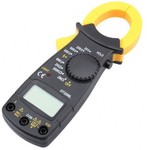Today Newfrog.com kindly offers OZ members this digital multimeter electronic tester with such cheap price—now only AUD$6.51 which was AUD$ 18.4.
Attention: The deal 24 hours only.Fast!!!
Features:
This meter uses large scale integration and unique function circuits.
It can measure AC Voltage, DC Voltage, AC Current, resistance, and fulfill audible continuity test.
With the function of phase indication and identifying live-wire, this clamp meter is an ideal instrument for electricians.
Specifications:
Display: 3.5 digital LCD with a MAX reading of 1999, Auto polarity display
Measure method: double integral A/D switch implement
Sampling speed: 2 times per second
Over-load indication: "1" is displayed
Operating Environment: 0~40 Celsius degree, at
Storage Environment: -10~50 Celsius degree, at
Power: 2 size AAA batteries (Not include)
Low battery indication: support
Static electricity: about 4mA
Clamp dimension: 25mm for open jaw; 35mm for inner diameter
AC Current:
Range AC2A Resolution 1mA Accuracy +/-(2.5%+10d)
Range AC20A Resolution 10mA Accuracy +/-(2.5%+10d)
Range AC200A Resolution 100MA Accuracy +/-(2.5%+10d)
Range AC600A Resolution 1A Accuracy +/-(2.5%+10d)
Note: test lead under measure should be put uprightly in the center of clamp sensor, or accuracy will be affected
DC&AC Voltage:
Range DC20V Resolution 10mV Accuracy +/-(0.8%+3d)
Range DC600v Resolution 1V Accuracy +/-(1.0%+3d)
Range AC600v Resolution 1V Accuracy +/-(1.2%+5d)
Input Impedance: =10MO
Resistance:
Range 2KO Resolution 1O Accuracy +/-(1.0%+4d)
Range 200KO Resolution 100O Accuracy +/-(1.0%+4d)
Range 2MO Resolution 1KO Accuracy +/-(1.0%+4d)
Overload Protection: 250V DC/AC virtual value
Phase Indication (50Hz)
Range: AC380V, Phase indication: OK/Reversal/MISS
Live Wire Test
Range: 180V~400V, Live wire detect: LIGHT or LCD indication
Color: As Shown
Package Included:
1 X Digital Clamp meter
1 X Set of test leads


Bought. Only 99999 available.